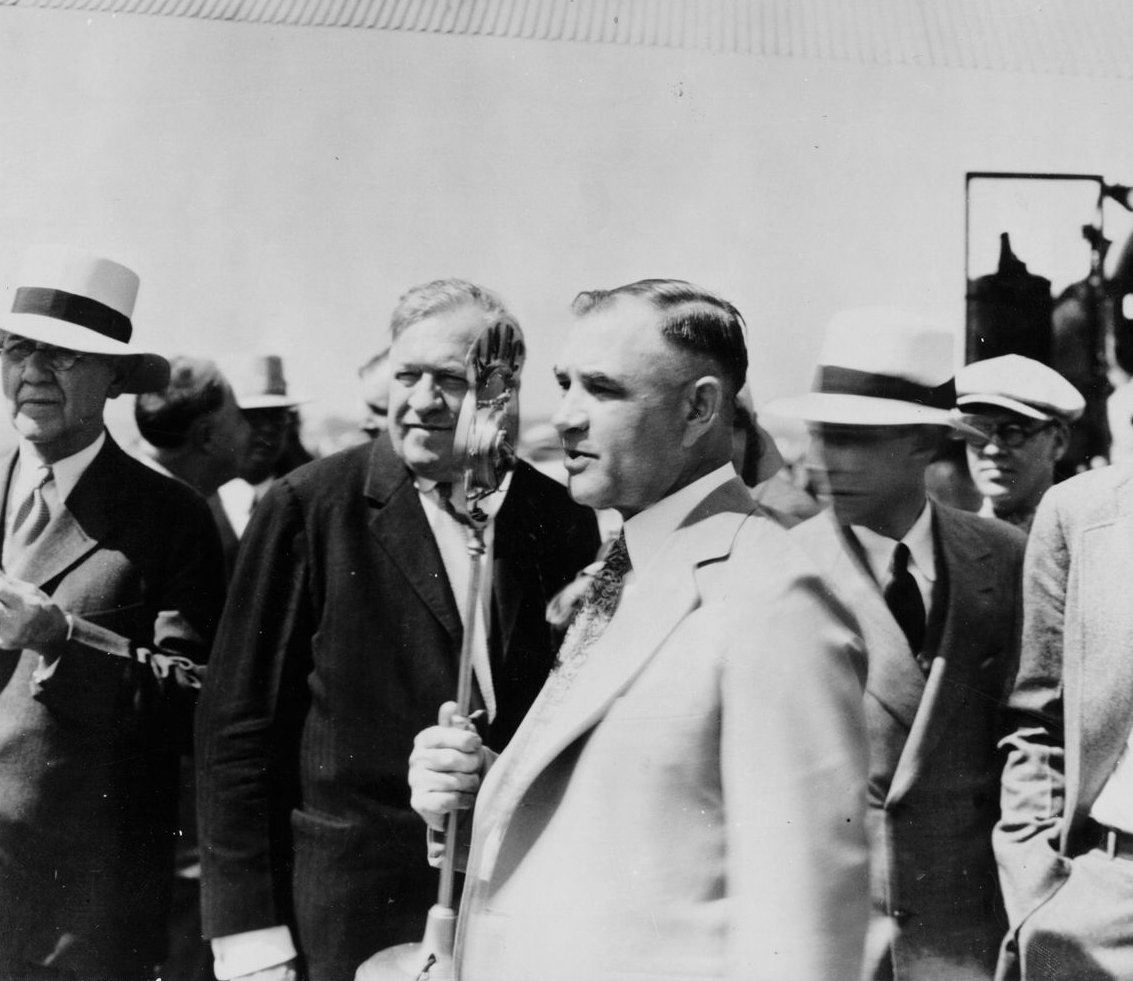Lindbergh Flies to Kansas City
On August 17, 1927, a jubilant crowd of 25,000 gathered at the site of the present-day Charles B. Wheeler Downtown Airport to listen to speeches given by Charles Lindbergh and city officials in order to dedicate Municipal Airport. Several Kansas City leaders, including a previously-skeptical City Manager Henry F. McElroy, had flown in from old Richards Field in Raytown and landed on the soggy turf known as "Peninsula field," just north of downtown Kansas City. Then, famed aviator Charles Lindbergh landed in his plane, the Spirit of St. Louis, and ushered in a new era of aviation in Kansas City.

At the time, Lindbergh was enjoying unparalleled adulation just three months after his sensational solo non-stop flight across the Atlantic; the first flight of its kind. His stop in Kansas City was a part of his celebratory trip across America to promote the potential for aviation to become a mainstream, safe, and economical method of travel and trade. During his speech, Lindbergh mused that Kansas City could become the most important hub of American aviation due to its central location and the new airport's close proximity to downtown.
All of the 1927 fanfare was possible due in large part to the efforts of Lou Holland, the president of the Kansas City Chamber of Commerce since 1925. Upon assuming this post, Holland became aware of the U.S. Army's plans to remove its aviation operations from the Kansas City area due to the substandard condition of and limited space allocated to Richards Field. Holland reasoned that a new airport could keep the army in Kansas City. More radically, he foresaw an era in which airplanes would partially displace trucks and trains in the transport of people and goods. This was a bold vision to emerge from a time when airplanes were seen as the tools of daredevil barnstormers and risky military operations.
City Manager McElroy first dismissed Holland's requests for an airport off-hand with his belief that flying was a fad that would disappear as crashes and deaths mounted. McElroy's opposition soon subsided, however, as two events fell into place. First, the Army Air Corps Reserve Officers' Association recommended a site for the new airport on the peninsula connected to Kansas City by the second Hannibal Bridge. Second, it came to the attention of political boss Tom Pendergast that the runways and terminal at a new airport would require extraordinary amounts of concrete - a demand he was more than willing to supply with the services of his Ready Mixed Concrete Company.
Now with the support of the city officials, Lou Holland was able to bring Charles Lindbergh to Kansas City to promote development of the new airport grounds, which had yet to be improved. After Lindbergh's 1927 visit, the city raised a million dollars in bonds and constructed concrete runways and a $60,000 airport "station" that was among the best air terminals in the nation. On the dedication day, revelers simply called the airport "New Richards Field" or "Peninsula Field." It was soon officially named, "Municipal Airport," a title which it kept until it was renamed the "Kansas City Downtown Airport" in 1977 and then the "Charles B. Wheeler Downtown Airport" in 2002.
Lindbergh's prediction that Kansas City would become the center of American aviation came true, for a time. When the airline, Transcontinental and Western Air (later known as TWA) searched for a new city for its new headquarters, the company consulted Lindbergh, among others. Holland once again intervened to remind Lindbergh of his earlier prediction for Kansas City's future. Lindbergh accordingly reaffirmed his opinion about Kansas City's advantages. In 1931, the future TWA moved its headquarters to Kansas City, and Municipal Airport assumed the self-proclaimed title, the "Air Hub of America."
Municipal Airport hosted commercial air service to Kansas City until the opening of the Kansas City International Airport in 1972. By then, Municipal Airport was too small to accommodate the larger jet planes that the airlines were then using. Today, the Wheeler Downtown Airport continues to serve private air traffic from businesses and individuals while Kansas City International accommodates the larger commercial traffic. Kansas City has since been supplanted as a major hub of American aviation, but in the early decades of commercial aviation the Municipal Airport and TWA kept Kansas City in the lead.
A previous version of this article appears on kchistory.org: http://kchistory.org/week-kansas-city-history/aviation-takes
This work is licensed under a Creative Commons Attribution-NonCommercial-NoDerivatives 4.0 International License.
